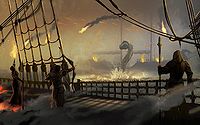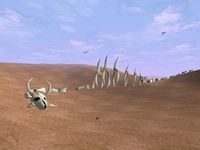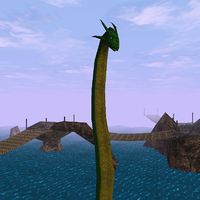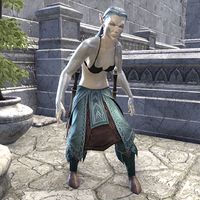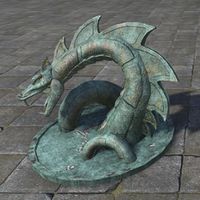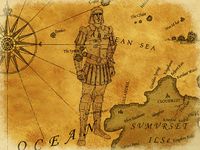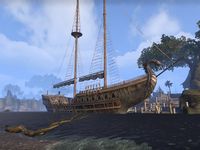Lore:Sea Serpent
| Sea Serpents | |||
|---|---|---|---|
 A Sea Serpent A Sea Serpent
|
|||
| Type | Beast (Reptile) | ||
| Range | Eltheric Ocean, Pyandonea | ||
| Appears in | |||
Sea Serpents are large reptilian sea monsters native to Pyandonea, capable of reaching 64 feet above the water in height.[1] These snakes are said to be large enough to capsize warships.[2] One story mentions a sea serpent twice the size of a war galleon coiling around such a ship and dragging its broken hull beneath the sea.[3] They are described by the Khajiit explorer Ja'dasha as among the most horrible and dangerous creatures of the sea, along with krakens and Sloads.[4]
Maps depicted serpents in the waters south of Stros M'Kai,[5] and the skeleton of a serpent was found in the sands of the island circa 2E 864.[6] Reef Vipers, another aquatic species native to Pyandonea that are trained by the Maormer,[7] may be related.[2]
Sea serpents are known for their distincive head frills.[8] They are said to twist around each other when they mate.[9]
Religion and Culture[edit]
Sea serpents are tamed and ridden by the Maormer for use as steeds and warbeasts to support their navy, and can be summoned by them during combat. It is said that this is possible through the powerful snake magic of their king, Orgnum.[10][11] Maormer ships are decorated with sea serpent designs and are capable of passing through the thick kelp around Pyandonea, which serves as a well-camouflaged home for the sea serpents that are Orgnum's guards and occasional mounts.[12] Their hide and teeth are also used by Maormer to craft their gear.[13][14] The Maormer often use serpent iconography in their weapons, armor,[13] banners,[15] and most notably their totems.[16] Sea serpents were used by the Maormer during the Battle of Seaside Sanctuary against the First Aldmeri Dominion,[17] and they attempted to break the wards binding a century old sea serpent in Greenshade.[18][19]
It is said that sea serpents are sacred to the Maormer.[13] The Maormer are known to have made shrines to a serpent god, with some theorizing these to be representations of Orgnum,[20] who is believed by some to be the Serpent God worshipped by the Satakal,[10] and who fanatical Maormer such as Serpent Caller Vinsha had seen in visions.[21][22] There are rumors among the people of Tamriel that Maormer Leviathans are the spawn of some unholy and sorcerous coupling of Sea Elf and Sea Serpent.[23]
In the writings of Azadiyeh, the Songbird of Satakalaam the Yokudan god Satakal is described as rising from the "starry depths" to pull Yokuda beneath the waves.[24] Satakal is elsewhere in Yokudan mythology said to cyclically eat the world only for it to be reborn again.[25] A traditional Redguard maxim speaks of a "serpent made of the sea below".[25] A statue in Hews Bane of a woman with a sea serpent wrapped around her was theorized to be the Yokudan queen Hazadiyya Sea-Queen.[26]
In writings associated with the Atmoran religious group the People of the Serpent, the Serpent is described variously as a god of the sea and as the sea itself.[27] Multiple scholars have theorized that the Cyrodiilic god Arkay was a fusion between the elven Xarxes and the Atmoran death god Orkey,[28] and devotees of the later Nordic pantheon revered Orkey as a snake.[29] Whether his associations with the oceans survived is unknown. The Nords of Solstice believe that during their voyage to the island, their ship became trapped in an unnaturally long night, caused by a giant snake named Sumodah[30] blocking out the sun. It is said that the hero Njor the Brave dreamed of a fox, whose tail curved back into a bow and its whiskers lengthened to arrows, and Njor fired a shot from Sovngarde into the snake's heart. When the rest of his crew came to look for him, Njor was gone.[31]
The followers of Syrabane fashioned bows in the shape of sea serpents.[32]
Gallery[edit]
A tattered silk veil embroidered with Maormer runes of rulership and bearing the entwined image of mating sea serpents[9]
A statue possibly depicting Hazadiyya Sea-Queen with a sea serpent wrapped around her[26] (ESO)
See Also[edit]
- For game-specific information, see the Redguard and Elder Scrolls Online articles.
References[edit]
- ^ Game Insider on Redguard's old site
- ^ a b A Sailor's Guide to Sea Elves — Virillda of the Silver-Sails
- ^ The Saga of Captain Wereshark
- ^ The Elder Scrolls: The Official Survival Guide to Tamriel — Tori Schafer
- ^ Map of West Tamriel
- ^ Events of Redguard
- ^ Justiciar Tanorian's dialogue in Culling Serpents
- ^ Coiled Serpent Lock antiquity codex entries in ESO
- ^ a b Serpent-Veil of Orgnum item description in ESO
- ^ a b Pocket Guide to the Empire, 1st Edition: The Wild Regions — Imperial Geographical Society, 2E 864
- ^ Fang of the Sea Vipers — Telenger the Artificer
- ^ Pocket Guide to the Empire, 3rd Edition: Other Lands — Imperial Geographical Society, 3E 432
- ^ a b c Crafting Motif 64: Pyandonean Style — Telenger the Artificer
- ^ Sea Serpent's Tooth of the Twin Sisters item description in ESO
- ^ Letter to Captain Oghul — Dulzur
- ^ Maormer Totem furnishing description in ESO
- ^ Pelidil's End quest in ESO
- ^ Sealing the Great Serpent
- ^ The Serpent Lord quest in ESO
- ^ Maormeri Serpent Shrine antiquity codex entries in ESO
- ^ Druid Farel's dialogue in ESO
- ^ Serpent Caller Vinsha's dialogue in ESO
- ^ The Scaled Elves — Marin Laroix
- ^ The Hunger of Sep — The Unveiled Azadiyeh, Songbird of Satakalaam
- ^ a b Knowing Satakal
- ^ a b Lady in the Cistern: Quen's Theory — Quen
- ^ The Atmoran Cult Writings — Archivist Oriane Pamarc
- ^ Tu'whacca, Arkay, Xarxes — Lady Cinnabar of Taneth
- ^ The Song of Gods
- ^ Praise for the Fourteen — Knudnar
- ^ The Founding of Shor's Stand — Ingorhild, Village Historian
- ^ Crafting Motif 112: Syrabanic Marine Style — Matthias Vervins
